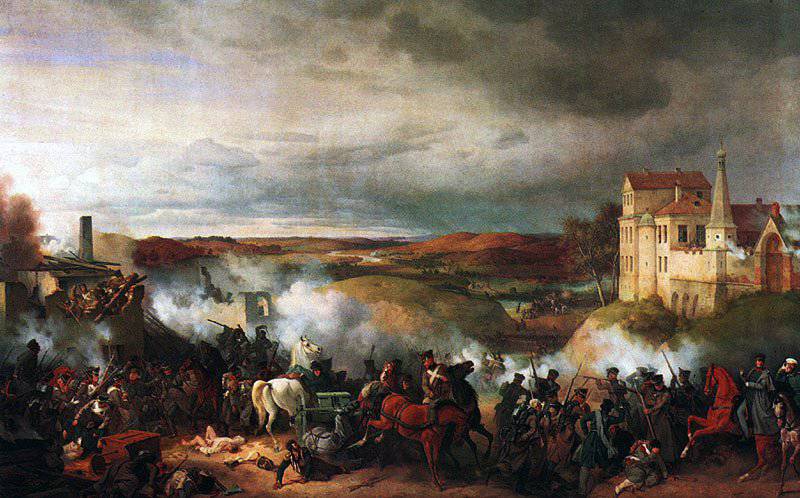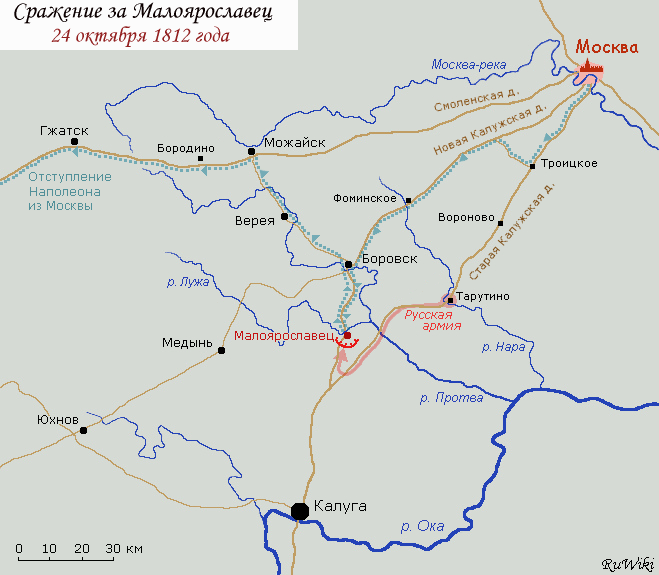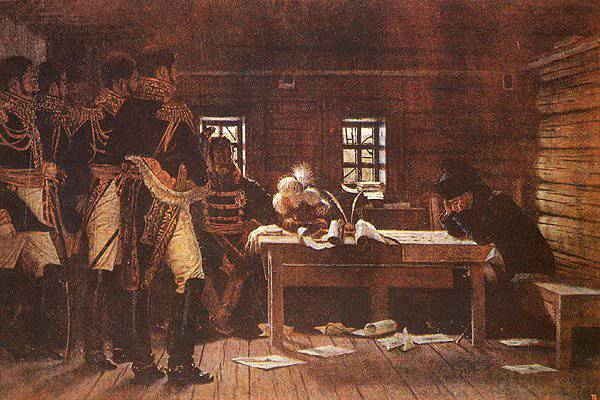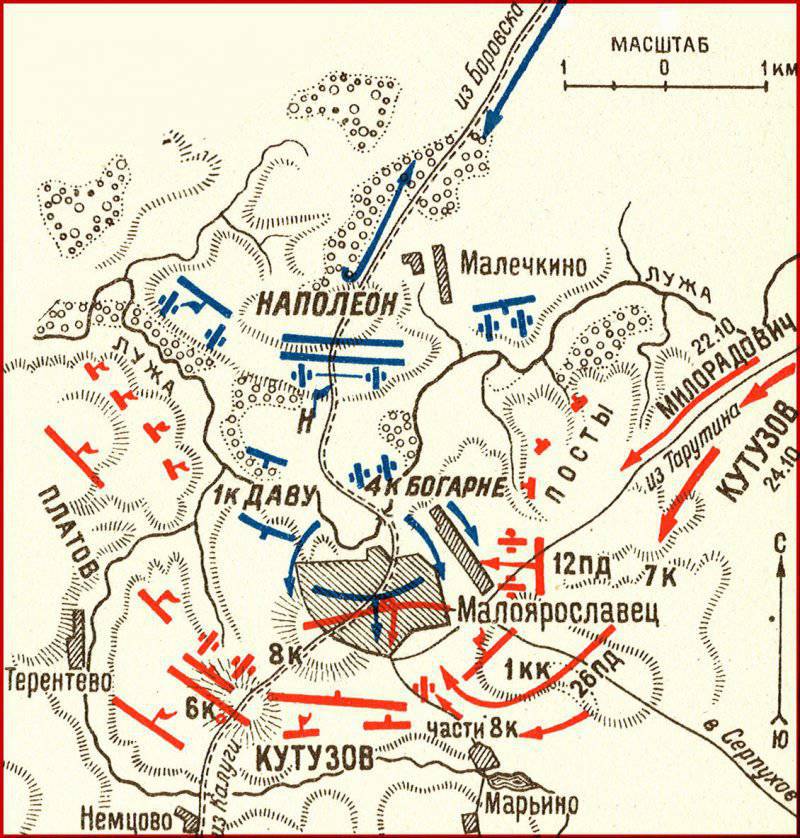Radical change in the course of the Patriotic War: the battle for Maloyaroslavets 12 (24) October 1812

The small Russian city of Maloyaroslavets was destined to fulfill a significant role during the Patriotic War of the 1812 of the year. Here 12 (24) October 1812, the Russian army halted the advance of Napoleon’s troops from Moscow to Kaluga. The French emperor, having lost hope of making peace with Alexander I, wanted to leave Moscow and retreat. However, he did not want to retreat across the ravaged territory, but through areas still unaffected by the war, lying to the south-west of Moscow. The main forces of the French army planned to withdraw from Moscow on the old Kaluga road, and then upgrade to the new Kaluga road and move through Borovsk and Maloyaroslavets on Kaluga. According to the French command, there were significant warehouses of food collected for the Russian army. From Kaluga, the French emperor was going to turn to the west. To implement this plan, Napoleon Bonaparte needed to hide his maneuver from the Russian command so that the army of Mikhail Kutuzov, located in Tarutino, was there as long as possible and did not have time to block the way to Kaluga for the French troops.
7 October 1812, the French army marched from the ancient Russian capital along the Old Kaluga Road. The 4 Infantry and 3 Cavalry Corps of the Great Army were in the forefront. The commander of this avant-garde was the Italian Viceroy Prince Eugene Beauharnais, stepson of the French Emperor. October 9 The French avant-garde 1812 arrived in the village of Fominskoe, and from there the October 10 moved to the village of Kotovo.
Mikhail Illarionovich Kutuzov was convinced that the enemy would soon begin to retreat along the Smolensk road. This was confirmed by the news of the preparation by the enemy of large stores in Smolensk and Vilna and the concentration there of large reserves that could be relied upon during the retreat. After the battle of Tarutino strength Murat 6 (18) in October 1812 years Kutuzov gave troops the order to be ready to go on the offensive. At the same time, a circular was sent to the commanders of the army partisan detachments, in which it was supposed to keep in mind two variants of the enemy's action: Napoleon’s army would join forces to give the Main Russian Army a general battle at the Tarutinskaya position, or begin to retreat beyond the Dnieper. In the first case, the commanders were instructed to observe the enemy, promptly report on his movement and approaching the positions of the Main Russian Army, threaten the French from the flanks and rear. In the second case, try to preempt the enemy on the march, using the “scorched earth” tactics, destroying food and fodder stocks along the way.
Kutuzov's assumptions were justified: starting from 1 (13) in October, Napoleon conducted inspections for the troops. Then he sent all the wounded to Smolensk and gave the order to provide all the corps with food for 20 days. This reserve should have been enough for Smolensk. The situation was worse with fodder, although the number of equestrian personnel of the French army was greatly reduced. After all the preparations, all that remained was to choose the road to Smolensk. Three roads led to the west. The first through Mozhaisk to Smolensk; the second, north of the Smolensk road, through Volokolamsk, Zubov and Vitebsk; the third road went through Vereya, Yelnya and stretched to Smolensk. The first road was the shortest and best known. However, the movement through it gave the impression of fleeing, and Napoleon wanted to preserve the appearance that he was not retreating, but carrying out a retreat to winter apartments in order to continue the Russian campaign in 1813 year. The second road was more acceptable, but subject to the preparation of stores. The French Emperor did not rule out this option and 5 (17) in October made a sketch of the plan, according to which the army was to go to the north-west, creating a threat to St. Petersburg and Riga. But in this case, the Russian army remained in the rear, so most of the marshals opposed this plan.
There was a third road, near which Russian bases were located. Their capture solved the problem of providing the army with food and weaponsand put the Russian army in a difficult position, depriving it of its supply bases. Coming out of Moscow, Napoleon wanted to hide his intentions. He said that the French army left Moscow only to seize Tula, Kaluga and Bryansk, where the main stores of weapons, ammunition and food supplies of the Russian army. To reinforce this fraud in the old Russian capital, 8-thousand was left. detachment under the command of Marshal Mortier, it was composed of one division of the Young Guard, reinforced by other parts. Napoleon, angered by Alexander’s refusal to conclude a peace agreement, ordered Mortier to mine the Kremlin and blow him up when he left. In addition, each French corps left for the detachment, they had the task to strengthen the approaches to Moscow. However, no one believed these statements, and the soldiers of the French army tried to take with them as much as possible of the loot. Napoleon's army was so burdened by the stolen property that it completely lost its maneuverability. Napoleon could no longer order the army to leave the loot in Moscow, since the discipline had seriously fallen, and he himself promised the troops all the treasures of the Russian capital.
Behind the avant-garde of the Italian viceroy was Ney's 3 Infantry Corps, Davout's 1 Corps, and the Old Guard. They were followed by the Young Guard and Colbert's Guards Cavalry. 7 (19) October Napoleon received a report from Murat, who said that he was standing by Voronov on the north bank of the River Urine. He also said that the Russians were watching him, but they did not enter the battle. The need to move along the Old Kaluga road fell away, since Napoleon did not seek a general battle at Tarutin. His goal was to bypass the Russian army along the New Kaluga road, in order to reach Maloyaroslavets, then Kaluga and possibly Thule, then turn onto the Smolensk road. However, success in implementing this maneuver completely depended on its suddenness and speed. And here Napoleon had huge problems. Due to lack of horses, artillery park had to seriously cut, large cavalry units have almost disappeared, Guards cavalry numbered only 4,6 thousand. Riders. It was the cavalry that had to play a decisive role in such a maneuver: to conduct reconnaissance, to mask the army movement with its actions, to cover the infantry. From the very beginning, the lack of cavalry doomed to failure the suddenness of the Kaluga maneuver.
Still, Napoleon decided to take this step, hoping to deceive the vigilance of the Russian commander and go to Kaluga. To this end, the corps of Ney was sent from Troitsky to Voronov, and the main forces turned from Red Pakhra to Fominsky. The French headquarters remained in Fominsky. From there, Napoleon ordered the Chief of Staff Berthier send 8 (20) October Tarutine Colonel Bertemi a letter to Kutuzov. In it, the French emperor proposed to the Russian commander to give up the methods of the "small war" and to give the war "a course in accordance with the established rules." The main task of Bertemi was to make sure that the Russian army was in the Tarutino position and to misinform the Russian command, saying that the letter was sent from Moscow. To this letter, Kutuzov replied that "it is difficult to stop the people, hardened by all that he saw, the people who for two hundred years did not see wars on their land, people ready to sacrifice themselves for their homeland and who makes no distinction between accepted and what is not accepted in the wars of ordinary ".
Having received a message from Bertemi that the Russian army was still in position with Tarutino, Napoleon hurried. The main forces were sent to Borovsk, the corps of Poniatovsky - at Vereya. Marshal Mortier was ordered to blow up the Kremlin and public buildings in Moscow and join the main forces at Vereya. Junot received an order to prepare in Mozhaisk to speak at Vyazma. Mortier forces left Moscow on the night of 8 (20) on 9 (21) of October. The French were able to blow up several towers in the Kremlin, destroy the arsenal, the palace, the Faceted Chamber burned down. Greatly damaged cathedrals. Most of the mines did not explode, fires ceased, heavy rains began. The intention to destroy the symbol of Russia - the Kremlin, was not justified by any military motives, in fact it was the revenge of a strongly irritated person. Napoleon solemnly declared: “The Kremlin, the arsenal, the shops are all destroyed; this ancient citadel, the same age as the beginning of the monarchy, this ancient palace of the kings, like all of Moscow, was turned into piles of rubble, into a dirty, disgusting cloaca, having no political or military significance. "
After giving instructions to the main forces to move to Borovsk, Napoleon ordered that part of Viktor’s corps be moved to Elne in order to ensure communication with the main forces and ensure actions on Kaluga. 11 (23) October Berthier ordered the troops to speed up the march to preempt Kutuzov's forces from Maloyaroslavets. As a result, Napoleon was not looking for a general battle at all; on the contrary, he tried to break away from the Russian army. At the same time, he pretended that everything was fine.

Movement of the Russian army
Enemy maneuvers did not hide from the Russian command. The information Kutuzov received from the partisan detachments allowed him to solve the enemy’s plan in time and take retaliatory measures. Seslavin's squad discovered the appearance of enemy forces on the New Kaluga road. Partisan group Seslavin acting between Smolensk and Kaluga roads, 4 (16) in October came to Fominsk, and established contact with a group of Dorokhov. Dorokhova squad originally had the task to strike the rear of Murat in Tarutino battle, but then he changed the mission and ordered to be put forward to the Kaluga road. Dorokhov moved to Kamensky, but then returned to the area of Kiselevka - Kamensky. Here he received news of the appearance of the French in the village of Maltsevo. Connecting with the squad Figner, Dorokhov attacked the enemy from Maltsev, but was forced to retreat under the onslaught of superior forces. Seslavin told Dorokhov that the French 7 (19) of October occupied the Fominsky large forces. At the beginning, Dorohov assumed that this was a large detachment of foragers and asked Konovnitsyn for two infantry regiments to attack the enemy. After receiving reinforcements, Dorokhov again attacked Maltsev. It was necessary to abandon the attack on Fominskoe, and to withdraw when it became clear that the divisions of the Brusy and Ornano were standing there.
On the night of October 8 on 9, Dorokhov informed Konovnitsyn about the concentration of French troops in Fominsky. He suggested that these forces put forward to cover the road from Moscow to Raven, Fominskoe, Ozhigova and Mozhaisk or the vanguard of the entire enemy army, which goes to Borovsk. The report of Dorokhov was also confirmed by other news received on October 8 and 9. Kutuzov sent to Fominsk 6-th infantry corps Dokhturov, 1-Cavalry Corps Meller Zakomelsky and six regiments of the corps Platov. Dokhturov was supposed to attack the enemy divisions in Fominsky. 10 (22) of October Dokhturov forces connected with the detachment of Dorokhov in Aristovo. Soon Dokhturov received a report from Seslavin that the main forces of the French army were marching towards Fominsky. The general told Kutuzov that Fominsky had troops of Nei and Old Guard corps. Kaluga Governor-General notified Kutuzov that the French units had entered Borovsk. Then Miloradovich, who was observing the forces of Murat, said that the forces of the Neapolitan king were moving away from Voronovo to Borovsk.
It became absolutely clear that Napoleon’s army marched to Kaluga through Borovsk and Maloyaroslavets. The commander-in-chief ordered Dokhturov to advance to Maloyaroslavets. Major General P. N. Ivashev was given the task of bringing in the crossings and preparing the roads leading from Tarutino to Maloyaroslavets. Miloradovich was ordered to continue to monitor Voronov, and then retreat to Tarutino, which is to cover the rear of the Russian army during its maneuver.
The Russian army marched to Maloyaroslavets in two columns. The first column of Borozdin includes the 7-th and 8-th infantry corps, 2-I cuirassier division. The second column of Lavrov included the 3-th and 5-th infantry corps, 1-I cuirassier division. Earlier, from the avant-garde Miloradovich, Platov's corps was sent to Maloyaroslavets, he had the task of advancing on the Bohr road and, together with Dokhturov's forces, to cover Maloyaroslavets from the north.
The course of the battle
The transfer of Dokhturov's troops took place in very difficult conditions: heavy rains washed away the roads, the crossings were ruined. In the evening of October 11 (23), a corps in the village of Spassky joined the Cossacks of Platov. Dokhturov’s forces reached Maloyaroslavets only on the night of October 12 (24) and found that the city was occupied by the enemy. These were two battalions from Delzona’s division (from the avant-garde of Beauharnais).
Dokhturov, finding out that the enemy’s weak forces were located directly in the city, decided to attack. He threw into the battle two regiment of chasseurs, the French were driven back. However, at dawn, Delzon threw his troops into battle and pushed the Russians out of the city. Dokhturov sent to reinforce another regiment of Chasseurs, Jaegers headed Yermolov, who was at 6-m body, again drove the enemy out of the city. The rest of the Dokhturov infantry occupied the heights, blocking the road to Kaluga. Simultaneously, the 1 Cavalry Corps and the Dorokhov detachment occupied the road to Spasskoye. The artillery was reduced to two large batteries that were placed in front of the 6 and 1 buildings.
Delzon threw all his forces into battle. The battle broke out with a new force. The French divisional general Delzon personally led one of the counterattacks and fell in battle. The division was headed by General Gil'emino, who gave the order to seize the hill dominating the western part of the city. In 11 hours, the battle took on an even more fierce character, Beauharnais brought the battlefield division to battle. By noon, 9 of thousands of French (13 and 14 divisions) and 9 of thousands of Russian soldiers fought in the city. The French acted bravely and energetically, they again fought off the city and even attacked parts of the 6 corps standing on the heights. However, the attack of the French infantry, undertaken without artillery support, was repelled by fire and bayonet attack. Then the Russian units again captured Maloyaroslavets.
By 2 hours of the day, the French commanders brought Pinot’s 15 Division and units of the Guard into battle. The Italian viceroy regained the position and began to threaten the Dokhturov corps. Russian troops with difficulty restrained the onslaught of the enemy. At that time, the 7 Corps of Raevsky (10,5 thousand people with 72 guns) approached and took up a position between the 6 Infantry and 1 Cavalry Corps. With his arrival, the number of Russian forces at Maloyaroslavets grew to 22 thousand soldiers with 144 guns. After receiving reinforcements, Dokhturov again led the troops to the attack and seized the city for the fifth time. Maloyaroslavets himself had no military significance, he was important as a springboard with which the French army could continue the planned movement. The city was badly damaged and burned.
However, the French soon regained the position, parts of the Davout corps were thrown into battle. The enemy again drove the Russian troops out of the city and attacked their positions on the heights. In favor of Russian troops played the factor that numerous enemy artillery (cannons to 300) is stuck on the ferries and on the northern outskirts of the city, not to take part in the battle. Russian soldiers let a attacking ranks of the enemy on the case-shot and met them at point-blank shots, then tipped the French bayonet and again recaptured the southern part of the city. Then two more enemy divisions led by Napoleon approached. Fresh parts of the enemy went on the attack. The thinned and tired troops of Dokhturov and Raevsky moved away and entrenched at the heights.
At 4 one o'clock in the afternoon I went to the city with the main forces of Kutuzov. He walked around the city from the south and firmly took the road to Kaluga in 1 — 3 km from Maloyaroslavets. Kutuzov took command, replaced the battered 6 corps with the 8 and hit the city again. Maloyaroslavets 8 once passed from hand to hand, and by the end of the day the situation was like before the battle: the city is from the French, and the Russian troops at heights to the south block the path to Kaluga. The city was almost completely destroyed.
Events after the battle. Battle results
13 (25) October troops stood against each other. Both sides studied the position of the enemy, preparing for a general battle. Kutuzov was ready to continue the fight. He suggested that the enemy might try to circumvent the Russian army and sent Platov’s corps to Vereya, ordered the Davydov and Shevelev units to reinforce the Cossacks, Miloradovich received the task to move west. In addition, the commander-in-chief ordered a departure from the city on the 2,5 mile to the south, taking up a new defense position. It must be said that the Cossacks of Platov in the early morning crossed the river Puddle and made a sudden raid on the camp of the enemy. 11 cannons were captured and Napoleon himself was almost captured with his retinue.
The French emperor held a military council in Gorodny, on which his marshals spoke of a plan of action. Murat offered to give him the remnants of cavalry and guards, with whom he was ready to pave the way to Kaluga. However, Napoleon said: “We have already done enough for glory. The time has come to think only about saving the remaining army. ” The opinions of the generals were divided, and then Napoleon Bonaparte made a strategic decision to depart along a different road. The forces of the two armies were about the same: Kutuzov - about 90 thousand soldiers, Napoleon - about 70 thousand. But the French were much inferior in artillery: 600 Russian guns against 360 French, and the ammunition was only one battle. In addition, Napoleon did not have strong cavalry, as under Borodino, and to attack the well-fortified positions of the Russian army in such a situation was very dangerous. 14 (26) of October was ordered to retreat to Borovsk - Vereya - Mozhaisk.
The French army had to retreat to Smolensk by the road along which it went to Moscow. The battle for Maloyaroslavets was in vain and only delayed the retreat of the French army. Mikhail Kutuzov won an important strategic victory. The strategic initiative has completely passed into the hands of the Russian command. The Russian army launched an offensive, pursuing the enemy.
In this battle, the Russian army lost about 3 thousand dead and wounded (according to other sources, about 6 thousand people). The French lost about 5 thousand people.

Napoleon at the council after Maloyaroslavets. Artist V. Vereshchagin: "In Gorodnya - to break through or retreat?"

Information